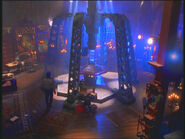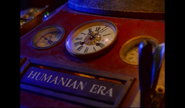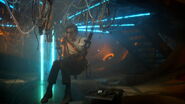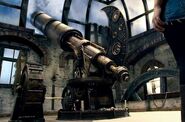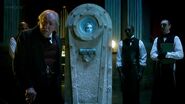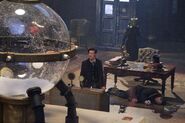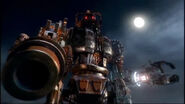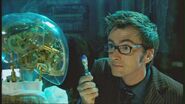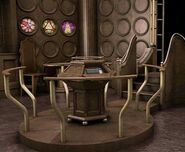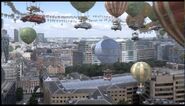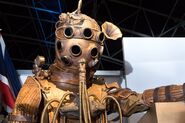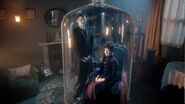Doctor Who, a successful British science-fiction series that has been running since 1963, explores concepts and stories spanning a range of worlds and eras both fictional and historical, through the medium of time-travel. A number of stories, both televised and in spin-off media, carry a distinctly steampunk flavor. Associated motifs are particularly common Christmas specials and episodes set during the reign of queen Victoria.
Examples (specific episodes)[]
Episodes Set in 1800s England[]
Reboot[]
- "The Crimson Horror" features a old woman who happens to be deranged chemist. She goes so far as to create a victorian styled rocket in order to poison the Earth. The controls for said rocket appear to be hidden behind an organ, and incorporate plenty visible spinning components. There's also human experimentation and plenty of societal themes. Gillyflower keeps the people she wants to preserve her self-made apocalypse preserved like dolls, sometimes posed under a glass case. The sound of pumps, perhaps aiding in air circulation, can be heard in the background.
- The secondary villain of "The Snowmen" is another wealthy entrepreneur, who appears to have created some weird devices (Such as large snow globe with extruding pipes) thanks to alien influence. When Simeon is reanimated, flashy spasms of electricity are course through his body, harkening back to Tesla or Frankenstein.
- The main antagonists of "Deep Breath" are a kind of clockwork robots. Said robots construct an air balloon out of human skin.
- "The Next Doctor" provides hot air balloons, and the giant cyber king powered by steam engine, which releases visible billows of smoke.
Classic[]
- "The Evil of the Daleks" is a very early example of the steampunk aesthetic in TV. Of note are a mad alchemist and the Dalek emperor.
Other Examples[]
Reboot[]
- "A Christmas Carol" uses aesthetics from the Victorian era (to fit the Christmas Carol theme) despite taking place on a futuristic planet. Kazran controls the weather with a panel decked out in wood and brass, and the large bolted bulky tanks used for cryogenic storage are distinctly Victorian in imagination, almost nautical.
- Similar to the "Deep Breath Example" further up the page, the Antagonists of "The Girl in the Fireplace", partially set in 1700s France, are also clockwork robots.
- "The Empress of Mars" pits a company of Victorian soldiers against Martians on Mars, having set out on an expedition with the help of a crashed Martian made their servant. Included is the Victorian interpretation of spacesuits. Expansionist themes abound.
- The telescope from "Tooth and Claw", set in the 1800s, seems to draws on a steampunk aesthetic. (It makes another brief appearance in "The Journey to the Center of the Tardis".)
- "Utopia" sees a rather Victorian looking Master, portrayed as brilliant inventor, at the end of the universe. Predictably, things are looking slightly dystopian. He sustains refugees with make-due technology practically held together with chewing gum. A pocket watch, that's really advanced technology in disguise, is integral to the plot.
Classic[]
- "The Pyramids of Mars", though set in the early 1900s, also partly takes place in a Victorian Mansion. A professor invents a primitive version of a radio telescope 20 years early, and a version of this device, later modified by the doctor, comes in handy. Though Lovecraft is only tangentially associated with Steam Punk, "The Pyramids of Mars is one of the more Lovecraftian Doctor Who stories, and also draws inspiration from gothic horror films like "The Mummy". Various advanced pieces of technology are disguised as ancient Egyptian artifacts.
Audio[]
- The Big Finish Audio "Time Works" sees the 8th doctor finds himself in a planet ruled by clockwork robots. Despite being reminiscent of medieval Earth, the society is littered with technological anachronisms.
- Doom Coalition 3 has more Steampunk theme especially with "The Eighth Piece" and "The Doomsday Chronometer" as the Doctor and his friends find Clockwork pieces that are part of a Timepiece, while facing Clockwork Robots knows as Solvers and a Time Lord who goes by "The Clocksmith".
Spinoffs[]
- The Iris Wildthyme Novel "A Clockwork Iris" is a compilation of stories featuring the titular character's adventures in a universe "filled with brass and copper", where "the skies are filled with Zeppelins" and "goggles are, for some reason, very much in fashion".
- The "Faction Paradox" novel "Warlords of Utopia" opens with the accounts of an a Roman empire from an alternate timeline that has made great advances in clockwork technology such, as automatons and windup tablets. While steam power is known to them, this Rome has no conception of electronics until they make contact with an alternate Rome. Even after exchanging technologies, many devices have to be adapted into clockwork equivalents to continue to function in their universe's Rome.
- The Tenth Doctor novel "The Resurrection Casket" mostly takes place on a planet where all technology more advanced than steam engines does not function. The result is that the planet relies on futuristic steam-powered tech that gives the whole novel a Victorian and steampunk vibe.
Honorable Mentions[]
Reboot[]
- With the help of an alien doctor (not that one), Mercy in "A Town called Mercy" gets electric lamps early. There is also the matter of a cyborg running around in the old west, a popular auxiliary setting for the steampunk genre.
- In the episode "Hide", the doctor uses, for the most part, whatever is laying around an old mansion, including clocks, in order to open a gateway to another dimension. Even the headpiece, alien tech, is like a bulky and bronze crown.
- "The Wedding of River Song" sees time come apart at the seems, resulting in an anachronism stew of all history happening at once. The results of this include a train running through the Gherkin, as well as a train running through the great pyramid. Cars are also seen attached to balloons.
Classic[]
- Despite the contemporary setting, the Doctor Who 1996 movie stars the 8th doctor, whose personal style is distinctly Victorian.
Steampunk elements[]
Political and societal themes, including imperialism, are examined on an episode by episode basis. Given the show's age, it's possible that the program had some influence on the early development of steampunk. However, while characteristics of what we'd now associate with the genre always had a presence in the series, they weren't as noticeable as they are in the reboot continuation, or presented with the same awareness.
Characters[]
The doctor himself fits the archetype of a mad scientist, inventor, and Victorian styled adventurer rather well. Among other things, he has a talent for making impressive gadgets out of the available junk of practically whatever time period he finds himself (see "Hide"). The Doctor's incarnations also share a few character traits with Sherlock Holmes. Both are perpetually ahead of their time, while still embodying some air of an old fashioned gentleman. The Doctor has a Moriarty of his own in the form of The Master. Meanwhile Missy might be described as evil Mary Poppins.
The second Doctor traveled for a time with a Victorian companion named Victoria. In the audios, the 8th Doctor had a companion named Charley, born in the Edwardian era, who dreamed of becoming an adventurer. To that end she stowed away on an airship. All Victorian era episodes to starring the 11th doctor showcase the married pair of detectives/adventurers (hinted to be the inspiration for Sherlock Holmes and Watson), Jenny and Vastra. The latter is a lizard woman hailing from deep under the Earth's crust. The former is an action girl of a maid hiding a leather catsuit under her gorgeous period dress.
Aesthetics[]
Apparel[]
The Doctor's dress sensibilities usually have a distinctly old-timey, Edwardian, or even Victorian bent. The 8th Doctor is a particularly fitting example, sporting an intricate waistcoat as well as a cravat and pocket watch.
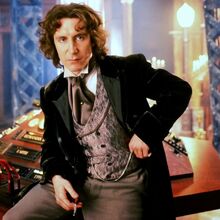
8th doctor.
In the episode "The Vampires of Venice", the Doctor can be seen hanging from a swing and tinkering with the machinery of the Tardis's Underbelly while wearing goggles that wouldn't look out of place in a steampunk cosplay. As a rule, the 11th doctor was also fond of wearing a bowtie. He would would later trade his tweed jacket for a frock coat and begin wearing a waistcoat underneath, commonly carrying a pocket watch.
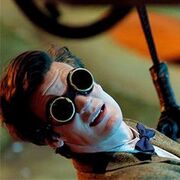
11th doctor wearing goggles.
The Master in the episode "Utopia" kept a similarly Victorian appearance. This was accompanied by him carrying pocket watch that was also an essential plot piece (a chameleon arch in disguise). Prior to this, the Chameleon arch made it's first appearance, again as a pocket watch, In "Human Nature" and "Family of Blood". Both examples are inscribed with circular Gallifreyan (the common written language of the time lords), which is itself modeled on the inner components of a clock. The Master's Victorian fashion sense would eventually carry over to Missy.
The Tardis[]
The Tardis is a time machine disguised as a wooden police box. Despite it's unfathomably advanced capabilities, the Tardis might at anytime have a type writer, or one of those flip-clocks, grafted the console. The ship is the definition of an extravagant anachronism. The 11th doctor's Tardis interior incorporates a leather swing under the controls. The 10th's has a noticeably industrial and bronze look, with Gabby describing it as a "Steampunk Nightmare" in "The Weeping Angels of Mons". Both are strung with a healthy helping of hanging wires and cables.
Regardless, the most gothic of any Tardis unquestionably belongs to the 8th Doctor. The interior dripped with gothic architecture done in wood and stone, homey Victorian furniture, and books. The color scheme was largely rust browns and muted reds beneath all the blue atmospheric lighting. Charley once complained that his Tardis resembled something out of Jules Verne more than what one would expect from a space ship. See Gallery.
Season 14 of classic Doctor Who introduced a secondary control room paneled entirely in wood, accented with bronze and stained glass windows.

